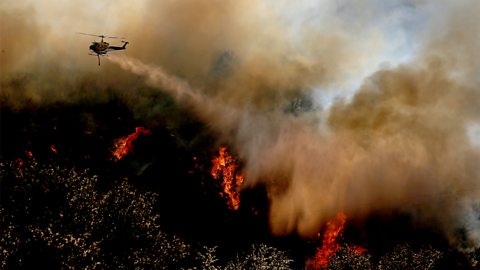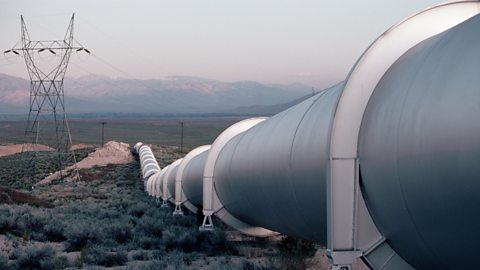High pressure systems
Global distribution of heatwaves and droughts
droughtA period of dry weather which dries up the landscape. and heatwaveAbove average temperatures. are often, but not always, closely linked. During a prolongLonger than usually expected. dry period, drought occurs and the land dries up. In addition, unusually higher than average temperatures may occur which exaggerates the problem вҖ“ a heatwave. The map below shows the regions of the world which experience drought. Some regions, such as the Sahara Desert, central Australia and California (USA), experience both heatwaves and drought. On the other hand, north-east Russia and parts of Chile (south America) also experience extreme drought, but not always heatwaves.
Drought in California
Almost every year, western America experiences drought. In recent years these events have become more frequent and intense. In 2012, record temperatures were set which were broken again in 2015 and then 2016. Between 2012 and 2015, a three year drought occurred when winter rainfall levels dropped to unusually low levels. As a result of this drought, water shortages across the region led to loss of vegetation and reduction in the water table and river levels. This was made even worse by wildfires which spread during the summer months. In total 22 people were killed across California between 2001 and 2016. This makes it the deadliest period in the history of California.

Causes of the Californian drought
The unusually high position of the jet streamThe ribbon of strong winds that circle the globe which separates cold northern air masses from hot southerly air masses. was to blame for the drought. Normally, during the winter months, low pressure systems would move down from the north bringing rain clouds. However, the jet stream was situated much further north than usual which allowed high pressure systems from Mexico to sit over California, bringing hot dry weather.
Impacts
Social
- В鶹ԼЕДowners were told to stop using water in their gardens вҖ“ a hosepipe banA law to prevent people using hosepipes for domestic reasons. was issued across the state.
- Many people were forced to flee and evacuate their homes.
- Some homes were destroyed by fire.
- People were injured and some even killed.
Economic
- Farmers lost almost $1 billion in resources - including buildings and equipment.
- Most hydroelectric power dams stopped producing electricity.
- The state lost over 17,000 jobs in agriculture.
Environmental
- Cracks appeared in buildings and roads, and water was pumped out of the ground faster than it was replaced by rain.
- Wildlife was destroyed as habitats were burned or damaged by drought.
- An estimated 12 million trees were burned.
- Salmon and trout were killed in major rivers because an increase in river temperature led to reduction in oxygen levels.
Longer term consequences
A major issue facing California is that groundwater supplies are not having the chance to recharge during the winter, which is unsustainable. Water is vital for commercial, agricultural and domestic useUsing water around the home, eg gardening.. This impact is a serious threat to businesses, and puts great pressure on the economy.
In addition, California has to erect controversial overland pipelines to meet the demand for water. These are expensive, unsightly and damage the landscape. People in other states also are angry that вҖҳtheirвҖҷ water is taken and piped to California.
